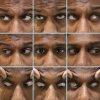Clinical Insight Into a Rare Anatomical Variation: An Autobiographical Case Report of a Supernumerary Extraocular Muscle (SEOM) in a Patient With Hyperthyroidism
- PMID: 37841982
- PMCID: PMC10568521
- DOI: 10.7759/cureus.46887
Clinical Insight Into a Rare Anatomical Variation: An Autobiographical Case Report of a Supernumerary Extraocular Muscle (SEOM) in a Patient With Hyperthyroidism
Abstract
In this case report, we present the rare occurrence of supernumerary extraocular muscles (SEOM) in a 35-year-old male with hyperthyroidism. SEOMs are unusual anatomical variations involving extraocular muscles that deviate from the typical muscle arrangement in the eye. While SEOMs are rare, they can have diverse clinical manifestations, including restrictive strabismus and lid abnormalities. In this case, the patient displayed right-sided lid retraction and an asymmetrical palpebral aperture, which raised concerns about a potential association with thyroid eye disease. However, imaging revealed that the SEOM was anatomically connected to the superior rectus muscle, possibly contributing to the observed lid retraction. Understanding the complexities of SEOM and its potential interactions with conditions like thyroid ophthalmopathy is crucial for accurate diagnosis and management. Further research is needed to fully comprehend the development and clinical impact of SEOMs due to their rarity and limited knowledge in the medical literature.
Keywords: hyperthyroidism; lid retraction; ocular anomaly; optic nerve compression; restrictive strabismus; supernumerary extra ocular muscle; thyroid eye disease (ted).
Copyright © 2023, Soundarajan et al.
Conflict of interest statement
The authors have declared that no competing interests exist.
Figures






Similar articles
-
Supernumerary Extraocular Muscle: A Rare Cause of Atypical Restrictive Strabismus.Medicina (Kaunas). 2022 Nov 21;58(11):1691. doi: 10.3390/medicina58111691. Medicina (Kaunas). 2022. PMID: 36422229 Free PMC article.
-
Thyroid eye disease presenting with superior rectus/levator complex enlargement.Orbit. 2020 Feb;39(1):5-12. doi: 10.1080/01676830.2019.1594969. Epub 2019 May 6. Orbit. 2020. PMID: 31056988
-
Bilateral optic nerve edema presenting as initial manifestation of thyroid eye disease.Orbit. 2016 Oct;35(5):288-91. doi: 10.1080/01676830.2016.1176217. Epub 2016 Aug 3. Orbit. 2016. PMID: 27486810
-
Ocular manifestations in children and adolescents with thyrotoxicosis.Exp Clin Endocrinol Diabetes. 1999;107 Suppl 5:S172-4. doi: 10.1055/s-0029-1212178. Exp Clin Endocrinol Diabetes. 1999. PMID: 10614915 Review.
-
Management of Thyroid Eye Disease-Related Strabismus.J Curr Ophthalmol. 2020 Mar 23;32(1):1-13. doi: 10.1016/j.joco.2019.10.002. eCollection 2020 Jan-Mar. J Curr Ophthalmol. 2020. PMID: 32510007 Free PMC article. Review.
References
-
- Vergleichend-anatomische beiträge zur kenntnis der augenmuskeln [Article in German] Nussbaum M. Anat Anz. 1893:208–210.
-
- Supernumerary extraocular muscle: a rare cause of atypical restrictive strabismus. Wang X, Shen T, Han M, Yan J. https://www.ncbi.nlm.nih.gov/pmc/articles/PMC9693874/ Medicina (Kaunas) 2022;58:1691. - PMC - PubMed
-
- An instance of the retractor bulbi muscle in man. Whitnall SE. https://www.ncbi.nlm.nih.gov/pmc/articles/PMC1288895/ J Anat Physiol. 1911;46:36–40. - PMC - PubMed
Publication types
LinkOut - more resources
Full Text Sources
